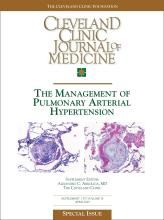ABSTRACT
The management of pulmonary arterial hypertension (PAH) should aim to provide vasodilation of the pulmonary arteries, treat right ventricular failure, improve functional capacity and quality of life, and improve survival, if possible. Data from right heart catheterization and an estimation of vasoresponsiveness together guide treatment for PAH. The judicious use of calcium channel blockers, prostacyclin analogues, anticoagulation, and endothelin receptor antagonists forms the current basis of therapy. Three drugs—the prostacyclin analogues epoprostenol and treprostinil and the endothelin receptor antagonist bosentan—are currently approved for the primary treatment of PAH and have been clinically shown to improve outcomes. Coumarin derivatives, epoprostenol, and, in selected patients, calcium channel blockers are the only drugs associated with improved survival, and only epoprostenol has been shown to improve survival in a prospective randomized trial. Knowledge of the supportive therapies, indications for surgical intervention, and emerging drug therapies should provide the working armamentarium for clinicians treating this rare but devastating disease.
- Copyright © 2003 The Cleveland Clinic Foundation. All Rights Reserved.






